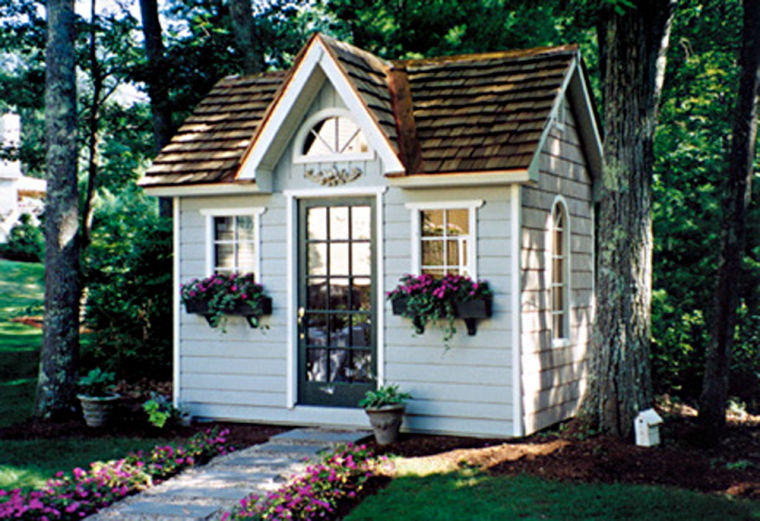So you've outgrown your home and need a little more room for an office or studio. Or maybe you want to add an architectural element to showcase your patio, pool, or deck. Or maybe you just want to have a quiet space so you can get away from it all. One answer is a backyard room.
They're called garden buildings in England and are popular throughout Europe. Now Americans are embracing the idea of adding a freestanding room to the back of their property. It's part of the trend of moving the outdoors in and the indoors out.
O.K., you probably call them sheds and think of them as a place to store lawn mowers. But the lowly shed has grown up. With the addition of windows, shingled roofs, and window boxes, the mundane shed begins to look and function more like a cottage or maybe a playhouse.
If you're an accomplished do-it-yourselfer, you can buy and build a prefabricated one in a few days for as little as $5,000 or $10,000, far below the cost to add a similarly sized room to your house. For prices starting at not much more, you can get an independent dealer locally who specializes in backyard structures to build one. At the upper end, an enclosed, outdoor pavilion designed by Michael Graves for Target and built by a Lindal Cedar Homes dealer can run $40,000 to $60,000.
Cedar ceilings
The best place to begin your search is on the Internet. That's what Jill Kelly did when she wanted a retreat in her backyard, an office where she could work on her novel. Kelly, a social worker on the faculty of California State University, Sacramento, ended up with a 10-ft.-by-12-ft. cedar-sided structure from Summerwood Products (summerwood.com), complete with five double-casement windows, a nine-pane door, and an interior cedar ceiling.
The price, delivered, was $8,895. It came as pre-assembled panels, and she hired a carpenter to erect it under an old camphor tree in her backyard and finish the interior. For that labor and extra materials, she paid an additional $8,000.
Another option is the new Ultimate Backyard Office kit from Cedarshed Industries (cedarshed.com). Starting at $12,999, it's a 10-ft.-by-12-ft. finished office with an attached 9-ft.-by-9-ft. deck and comes as panels, including floors, walls with prehung windows and doors, and a shingled roof. It's also sold by Lowe's.
The most popular sizes of backyard buildings are 10 ft. by 12 ft. and 8 ft. by 15 ft., and there's a reason. In most jurisdictions, that's the largest you can build without a permit. Any bigger, and you'll have to spend an extra $700 to $1,500 for permits and city fees, depending on where you live, says builder Paul Johnston, who owns The Shed Shop (shedshop.com) in Fremont, Calif.
Two years ago, Johnston, who works only in the Bay area, started selling a backyard room package in addition to the outside framework. The package adds windows and upgraded doors, a finished interior, paint, carpeting, electricity, and air conditioning, and takes the room from a base price of $4,382 for a 10-ft.-by-12-ft. model, for example, to about $10,000.
If, by now, you're already designing your backyard office in your head, here's what to keep in mind. Even without a building permit, you'll have to abide by zoning regulations. Usually, the structure will have to be set back a couple of feet from your property lines. If you're going to wire it, you'll probably need an electrical permit. Also, check with your homeowners' association, if you have one. The building may have to be situated so that it's not visible from the street, or its roof may have to match that of the main house.
Most of these buildings come with a floor. If you have a relatively level site you can support the floor frame with patio stones or concrete blocks. Otherwise, or if your city requires it for larger structures, you'll need some kind of foundation, such as concrete piers or a poured slab. Maybe you already have one: You can put your outdoor office on the corner of a patio or extend the wood framing of a deck to accommodate it.
If you want plumbing for a bathroom or small kitchenette, you're better off hiring a contractor to guide you through the maze. A simple backyard office or studio, even with electricity, is what's known as an "accessory building," just like a gazebo or — in fact — a storage shed. Plumbing is likely to turn your small addition into "habitable space" that's subject to the same building code as your house.
Finally, figure out how you'll keep the rest of your family from moving into your backyard haven. You may consider it your home office, but others may think it's a music room or an exercise studio. Maybe you should think about getting two.
